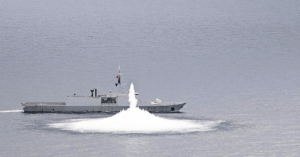
NYK & Partners Receive AiP For Ammonia Fuelled Ammonia Bunkering Vessel
February 25, 2025
Chinese-Crewed Ship Held In Taiwan For Severing Undersea Cable
February 26, 2025

The French Navy recently conducted a rare shock test on the Courbet, a La Fayette-class frigate, to assess its resilience to underwater explosions.
The test was carried out on January 25, 2025, off the coast of Toulon, France, as part of the POLARIS initiative that began in 2021.
The experiment aimed to evaluate how well the ship and its equipment could withstand a major blast, preparing for high-intensity combat scenarios.
During the experiment, a controlled underwater blast was detonated near the starboard side of the ship while it was moving at a slow speed.
Unlike the U.S. Navy’s method, where ships remain stationary during such trials, the French Navy conducted the test while the frigate was in motion.
The main purpose was to simulate the effects of a near-miss explosion, as naval mines and other explosive threats can severely damage vital onboard systems even without a direct hit.
#Expérimentation | La résistance de la FLF Courbet face à l’explosion d’une mine navale !
Cette expérimentation appelée “essai de choc” a été réalisée pour évaluer la résistance du bâtiment et des équipements à une explosion importante, dans un contexte de hausse des menaces. pic.twitter.com/bG4kWfwOUI— Marine nationale (@MarineNationale) February 25, 2025
The concept of shock trials dates back to World War II, when the U.S. Navy realised that near-miss explosions could disable critical ship functions, potentially taking a vessel out of service.
The U.S. Navy’s shock trials involve up to four controlled explosions on newly commissioned warships, with the most intense one reaching two-thirds of the ship’s maximum shock resistance.
These tests, though expensive-often costing tens of millions of dollars are crucial for identifying weaknesses in a ship’s design. Earlier, tests on the Arleigh Burke-class destroyers resulted in upgraded shock-resistance components after flaws were found in the first trials.
The French Navy has intensified its combat training due to growing geopolitical tensions and uncertainties in global security.
In December 2024, just a month before the shock test on Courbet, the navy fired an F21 heavy torpedo from a nuclear attack submarine (SNA) at the decommissioned frigate Premier Maitre L’Her, destroying it.
While that test focused on evaluating the weapon’s effectiveness, the shock trial on Courbet was aimed at assessing the resilience of the ship’s structure and onboard equipment.
The La Fayette-class frigates play an important role in France’s naval operations. These warships are designed for a range of missions, including protecting overseas territories, securing maritime trade routes, supporting intervention forces, and conducting special operations.
This was the first time the French Navy had conducted such a test since 1995 when a 250-kilogram TNT charge was detonated 40 meters below the surface and 30 meters away from another La Fayette-class frigate.
The goal then, as now, was to verify the durability of the ship’s hull against underwater explosions.
Reference: French Navy
Source: Maritime Shipping News



